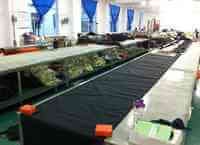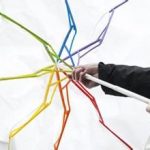Many products use textiles in good measure. One such textile product is the umbrella. An umbrella can be simply defined as a canopy for protection against rain, snow, or sunlight.
The term umbrella is derived from the Latin word umbra, which means “shade.” Umbrellas are generally hand-held portable devices that make fashion statements in some societies and are used as accessories in others.
However, some of these can be big enough to be fixed to patio tables or other outdoor furniture. They are the ‘Parasols’, a term that is also synonymous with umbrellas. Parasols can be bigger or smaller, but they are primarily meant for protection only against the sun.

Table of Contents
Fabric Selection for Umbrellas
Historically speaking, umbrellas were made from various fabrics, including linen, cotton, leather, a taffeta variety of silk, lace, and the special fabric that was first made for umbrellas only—the Gloria.
Gloria, which means ‘ bright’, is a plain weave of silk, wool, and cotton. Later, rayon and acetate were widely used for making umbrellas. Nowadays, the fabric generally used is nylon taffeta with an acrylic coating on the underside and a scotch-guard-type finish on the top.
Most recently, umbrella manufacturers have also used microfiber fabrics with new water-repellent finishes.
When using nylon taffeta, the fabric’s coating and finish are generally done by the fabric suppliers. It’s the umbrella manufacturers’ prerogative to select the fabric patterns and designs.
These umbrella manufacturers can even add their own patterns and designs with the help of rotary or silk screening processes, which is cost-effective only for a special order of a limited number of umbrellas.
The Making of Umbrella
Umbrella manufacturing is a hand-assembly process where various parts are joined to each other methodically. Apart from the canopy made of fabric, the umbrella’s other parts are the shaft, ribs, stretchers, runners, and handle. They can be made of wood, metal, plastic, or any other such material.
 Shaft
Shaft
It is usually made of wood, steel, or aluminum. Sometimes, Fiberglass and other plastics are used, as can commonly be seen in larger golf umbrellas. When made of wood, shafts are made with the help of wood-shaping machines such as turning machines and lathes. Metal and plastic shafts are drawn or extruded to give them the required shape.
Ribs and Stretchers
Ribs run underneath the umbrella’s canopy, and stretchers join the ribs with the shaft of the umbrella. They are assembled methodically to give the ribs a “U” shape and are usually made of steel or some other such metal.
The ribs are attached to the shaft by fitting it into a top not—a thin, round nylon or plastic piece with teeth around the edges, held with thin wire. The stretchers are connected to the umbrella shaft with a plastic or metal runner, the piece that moves along the umbrella shaft when it is opened or closed.
The ribs and stretchers are interconnected with a joiner, which is usually a small jointed metal hinge. When the umbrella is opened or closed, the joiner opens or closes simultaneously through an angle of more than 90 degrees. Then there are two catch springs in the shaft of each umbrella.
They are small pieces of metal that have to be pressed whenever the umbrella is slid up the shaft to open and again when it is slid down the shaft to close. Metal shafts are generally hollow so that the catch spring can be inserted in them without much effort.
A wooden shaft requires to be hollowed out to make space for the catch spring. A pin or other blocking device is usually placed into the shaft a few inches above the upper catch spring to prevent the canopy from sliding past the top of the umbrella when the runner goes beyond the upper catch spring.
Canopy
The umbrella’s canopy is hand-sewn to the ribs in individual panels. The canopy cannot be cut from one piece of cloth because each panel has to be shaped according to the curve of the canopy by following the thread pattern of the weave. Otherwise, the material will pull on the bias and create puckers.
Each panel is cut separately from piles of materials called gores. Machine cutting of several layers at once is also possible, which is less cumbersome. The standard rain umbrella has eight panels. However, smaller umbrellas, such as parasols and children’s umbrellas, can have six panels. The larger umbrellas can have as many as twelve panels, too.
A metal ferrule may or may not be forced over and glued to the tip of the umbrella that passes through the canopy. The handle made of wood, plastic, metal, or any other material is fixed at the end of the shaft with the help of a screw or glue.
The end tips of the cover where the ribs reach past the canopy may be left without any covering or may be covered with small plastic or wood end caps that are either pushed or screwed on, or glued and then sewn to the ends of the ribs through small holes in the end caps. This completes the process of making an umbrella.
 Variations of Umbrella
Variations of Umbrella
The above-described process is typically followed to make a stick umbrella. However, there are also collapsible rain umbrellas, which are mechanically more complicated than stick umbrellas, although they use the same basic technology.
The difference between the two is that while making a collapsible umbrella, a two-piece shaft that telescopes into itself is used. Apart from this, an extra set of runners along the top of the umbrella is also provided.
A good-quality umbrella is always comfortable to use and truly serves its purpose. At one point, an umbrella having a number of panels was considered to be of good quality, but with the improvement in the quality of fabrics and other materials, it no longer stands as a criterion for a good-quality umbrella.
When buying an umbrella, one should look for the comfort of the handle, the ease with which the umbrella is opened and closed, and the closeness with which the canopy segments are connected to the ribs.
Umbrella manufacturing process
Large Cut:
Cutting the suitable size of the fabric is the very beginning process, which is called “Large Cut,” sometimes called “First Cut.” This process involves using a machine or hand-cutting to cut fabric in a rectangular shape from a pile of fabric. It is the pre-stage for the second cut.
Small Cut:
This process is called “Small cut,” sometimes called “Second Cut.” The purpose is to cut the fabric from the rectangle into a triangle. Use wood to make a triangle shape of a flame as a mold. Place the mold on the rectangle fabric and hand-cut the fabric into a triangle. The triangle shape of the fabric is called a gore, which is the panel of the umbrella.
Printing:
In this case, we use silkscreen printing as an example (For details, please go to the “Printing Method” section). Place the gores on a long table. Then, put the wooden flame on each gore and print the graphic on the fabric.
Canopy Assembly:
After the printed gores are ready, the next process is the canopy assembly. In a normal umbrella, we sew eight pieces of gores together by sewing machine to make the canopy.
Umbrella Tip install:
The tip is a piece of metal or plastic stuck at the end of each rib to stabilize the canopy with the ribs. We use a special sewing machine to sew the tips on the fabric. The number of installed tips is the same as the number of ribs.
Join the frame and canopy:
The next process is to sew the canopy with each rib. This process does not use a machine; it is totally hand-assembled.
Handle install:
There are several methods to install the handle with the shaft, such as screwing on, heating up the shaft, or gluing to secure the handle.
Quality checking:
Quality Control is the most important area of each process. Therefore, we appointed QC staff for each production line and process. After all the assembly and production processes are finished, all the umbrellas will be sent to the quality control department to have the final quality-checking process before packaging.
Packaging:
All umbrellas that pass the QC test are sent to the packaging department to be packed into cartons. Normally, there are five inner cartons in each outer carton, each containing 60 pieces of umbrellas.
Buy quality umbrellas from a professional umbrella factory now!
Save your 30%-50% cost!
Email: info@hfumbrella.com What’s app:86 13527750521







